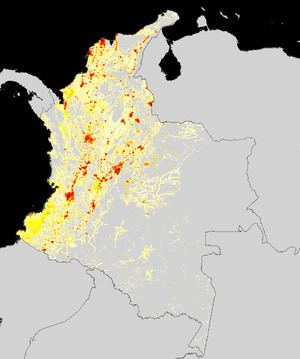Metropolitan Areas in Colombia are officially designated administrative and census areas, composed of an urban center and its associated Municipalities.
The following criteria must be met for a group of communities to be designated a Metropolitan Area:
Each one of the Municipalities, the secondary cities as well as the central city, must have a population of at least 50,000 inhabitants.The secondary cities must integrate their city planning with that of the central city.At least two-thirds of those employed in the area must perform non-rural activities.Each of the secondary cities must have at least 10% of their workers employed in the central city.Commuting to work is, in fact, the major characteristic of a Metropolitan Area. As a result, the secondary cities are often called "dormitory cities"; meaning places where the inhabitants only go home to sleep.
An important function of the Metropolitan Areas is to provide for joint planning between the Municipalities, thereby managing ordered and proportional economic growth according to the necessities of the area and the physical characteristics of each Municipality.
The following are currently (2007) recognized by the Colombian government:
Metropolitan Area of Medellín. Officially the Metropolitan Area of Aburrá Valley. The first metropolitan area in Colombia. Created by Decree 34 of 1980. Composed by the municipalities of Medellín, Bello, Barbosa, Copacabana, La Estrella, Girardota, Itagüí, Envigado, Caldas and Sabaneta.Metropolitan Area of Cúcuta. Created by Decree 000508 of 1991. Composed of Cúcuta, Villa del Rosario, Los Patios and El Zulia.Metropolitan Area of Bucaramanga. Created by Decree 20 of 1981. Composed of Bucaramanga, Floridablanca y Girón. In 1986, the newly incorporated Municipality of Piedecuesta was added.Metropolitan Area of the Midwest. Created by Decree 014 of 1991. Composed of Pereira and Dosquebradas. La Virginia was added after its incorporation and Santa Rosa de Cabal is waiting to be approved.Metropolitan Area of Barranquilla. Created by Decree 28 of 1981. Composed of Barranquilla, Puerto Colombia, Soledad, Galapa and Malambo.Metropolitan Area of Bogotá. Not yet defined officially. Composed of Bogotá and its 20 districts plus Soacha, Mosquera, Funza, Madrid, Chía, Cajicá, La Calera, Sopó, Tenjo, Tabio, Sibaté, Zipaquirá, and Facatativá.Metropolitan Area of Cali. Not yet defined officially. Composed of Cali, Palmira, Yumbo, Jamundí, Vijes and Florida.Metropolitan Area of Popayán. Not yet defined officially. Composed of Popayán, El Tambo, Timbío, and Piendamó.
